Dateline – February 14, 2018
An admission—this wildlife sighting did not take place inside our usual 10 county coverage area. BUT, a flock of some 5000 overwintering Snow Geese this close to Dallas/Fort Worth is such a special phenomenon that I decided to make and exception in this case!
In truth, this sighting really doesn’t require much special consideration. It occurred just a mile or two north of the Collin/Grayson county line. The metroplex is growing towards this area with great abandon. It may not be too long before it becomes difficult to exclude this part of North Texas from being regarded as part of the greater Dallas/Fort Worth area. DFW is booming!
Early reports about these geese had the giant flock on a single farmer’s field located on the north side of an east-west road. It was a week later before I was able to make the time to visit the site myself. By then the flock had moved to new locations a little further east and on the south side of the highway. Evidently they had eaten their fill of the rich green winter grass growing on the field where they had been originally sighted. A flock of this size can put away a LOT of foodstuff.
At the time of my arrival the geese were found collected in two different spots. One group was located high on a hill, well away from the road. The other was set up on a green grass field just next to the highway. Many of the geese on this field would be less that 100 yards away from the fence line, making this a primo spot for observing and taking pictures.
I quickly found a suitable spot to pull off the road and park. A short walk later and I was in position along the fence line. I took great care not to disturb the geese as I approached, and at this distance the birds were generally unconcerned with my presence. It helped that they were thoroughly preoccupied gorging on the lush green grass growing on this field.
By now it was late afternoon. The sun was drifting westward after finally breaking through the day’s low and heavy overcast. The lighting for this session was going to be ample, soft, and warm—just about as good as could be hoped for. Things were looking promising for this photography session!
From my vantage point at the fence line I could see both groups of geese—those directly in front of me, and the other group located far to the southwest on a hilltop. For much of the first hour, wave after wave of geese would leave their position on the distant rise and fly over to join their friends in the field. The sight of formations of big white birds coming into land was spectacular to behold. I was treated to it over and over again.

Snow Geese breed in the farthest reaches of North America. They nest in marshes and bogs on the tundra near the Arctic Ocean—that’s about as far north as you can get! As Autumn begins to set in, Snow Geese migrate en masse to more temperate climes. They spend the winter in several different places across the lower 48 and Mexico.
In Texas, Snow Geese can be expected to overwinter in a handful of locations—The panhandle, the Sabine River valley, and along the Gulf Coast most prominently. Migration to and from can take them—at least temporarily—through much of the rest of the state.
In the days before I made my trip up to Grayson County, I spent sometime reading up and trying to better understand what brings these flocks of Snow Geese to our part of North Texas. The question for me was whether the birds in this group were really overwintering here, or were they simply moving through as part of a slow migration back north.
The question was harder to answer than I first expected, so I looked to a State sponsored hunting guide for some clues. Texas Parks and Wildlife defines hunting season for Snow Geese—known as light geese to sportsmen—in the eastern part of the state as lasting from November 4 through March 18. But, these dates may only cover the historic congregations along the coast and the Sabine River basin.
Later, I found this article online: Dwindling Numbers of Geese Wintering on Texas Coast. This story documents a dramatic decline in the number of Snow Geese overwintering on the Texas coast that began in the 1990s. The article suggests that the geese are adapting to better food supplies in the interior of the state, and just skipping the trip to the coast as being unnecessary. Here’s how they describe the phenomenon:
At the same time, production of agricultural crops on which geese have come to depend has exploded in regions to the north. Arkansas plants more than 2 million acres in rice, and corn and other small-grain crops blanket much of the Midwest.
That’s where many of the geese that once wintered on the Texas coast can be found. The geese have shifted their wintering areas.
“Geese have proven incredibly adaptable,” Kraai said. “When they can find open water and abundant food, they’re not going to move any further south than they have to.
“It’s a trend we’ve been seeing. When you have a landscape covered with corn and there’s a power-plant lake or some other body of open water for them to roost on, that’s where they’ll stay, even if that’s in central Illinois. They go where they find the resources they need, and they’re finding those resources before they get to Texas.”
Also, recent years have not seen the intense, long-term freezing conditions that would lock up open water and food resources, forcing the birds to Texas.
“The cold snaps are cold, but they’re usually of short duration,” Kraai said, noting the birds might temporarily relocate but return as soon as the weather moderates.
“Across the board, goose species are doing better than ever – their numbers are way up,” Kraai said. “The irony is that we’re seeing fewer of those birds wintering on the Texas coast.”
Back on the field, things were beginning to get a mite crowded as more and more geese arrived by the minute. As the congregation grew, the leading edge pushed closer and closer to where I was positioned. This allowed me the opportunity to observe and photograph these gorgeous birds at a much closer range than I ever expected.
There are a couple of major varieties of Snow Geese—the Lesser Snow Goose which overwinters in Texas, and the significantly larger, Greater Snow Goose which spends its winters on the east coast of the United States.
Represented in our flock of Lesser Snow Geese were a wide range of ages and color morphs. The vast majority of the birds were the typical white-morph—both juvenile and adult. Also in the mix were several beautiful blue-morph adults and their darkly colored offspring. Evidently, at one time the blue-morphs were considered a separate species known as the Blue Goose. They are now known to be simply a unique color morph of the Lesser Snow Goose.
Wikipedia describes Snow Geese in this way:
The snow goose has two color plumage morphs, white (snow) or gray/blue (blue), thus the common description as “snows” and “blues”. White-morph birds are white except for black wing tips, but blue-morph geese have bluish-grey plumage replacing the white except on the head, neck and tail tip. The immature blue phase is drab or slate-gray with little to no white on the head, neck, or belly. Both snow and blue phases have rose-red feet and legs, and pink bills with black tomia (“cutting edges”), giving them a black “grin patch”. The colors are not as bright on the feet, legs, and bill of immature birds. The head can be stained rusty-brown from minerals in the soil where they feed. They are very vocal and can often be heard from more than a mile away.
White- and blue-morph birds interbreed and the offspring may be of either morph. These two colors of geese were once thought to be separate species; since they interbreed and are found together throughout their ranges, they are now considered two color phases of the same species. The color phases are genetically controlled. The dark phase results from a single dominant gene and the white phase is homozygous recessive. When choosing a mate, young birds will most often select a mate that resembles their parents’ coloring. If the birds were hatched into a mixed pair, they will mate with either color phase.
The species is divided into two subspecies on the basis of size and geography. Size overlap has caused some to question the division.[6] The smaller subspecies, the lesser snow goose (C. c. caerulescens), lives from central northern Canada to the Bering Straits area. The lesser snow goose stands 64 to 79 cm (25 to 31 in) tall and weighs 2.05 to 2.7 kg (4.5 to 6.0 lb). The larger subspecies, the greater snow goose (C. c. atlanticus), nests in northeastern Canada. It averages about 3.2 kg (7.1 lb) and 79 cm (31 in), but can weigh up to 4.5 kg (9.9 lb). The wingspan for both subspecies ranges from 135 to 165 cm (53 to 65 in). Blue-morph birds are rare among the greater snow geese and among eastern populations of the lesser.
Long-term pair bonds are usually formed in the second year, although breeding does not usually start until the third year. Females are strongly philopatric, meaning they will return to the place they hatched to breed.
Snow geese often nest in colonies. Nesting usually begins at the end of May or during the first few days of June, depending on snow conditions. The female selects a nest site and builds the nest on an area of high ground. The nest is a shallow depression lined with plant material and may be reused from year to year. After the female lays the first of three to five eggs, she lines the nest with down. The female incubates for 22 to 25 days, and the young leave the nest within a few hours of hatching.
The young feed themselves, but are protected by both parents. After 42 to 50 days they can fly, but they remain with their family until they are two to three years old.
Where snow geese and Ross’s geese breed together, as at La Pérouse, they hybridize at times, and hybrids are fertile. Rare hybrids with the greater white-fronted goose, Canada goose, and cackling goose have been observed
Snow geese breed from late May to mid-August, but they leave their nesting areas and spend more than half the year on their migration to-and-from warmer wintering areas. During spring migration (the reverse migration), large flocks of snow geese fly very high and migrate in large numbers along narrow corridors, more than 3,000 mi (4,800 km) from traditional wintering areas to the tundra.
The lesser snow goose travels through the Central Flyway, Mississippi Flyway, and Pacific Flyway across prairie and rich farmland to their wintering grounds on grassland and agricultural fields across the United States and Mexico, especially the Gulf coastal plain. The larger and less numerous greater snow goose travels through the Atlantic Flyway and winters on a relatively more restricted range on the Atlantic coastal plain. Traditionally, lesser snow geese wintered in coastal marsh areas where they used their short but strong bills to dig up the roots of marsh grasses for food. However, they have also since shifted inland towards agricultural areas, likely the cause behind the unsustainable population increase in the 20th century. This shift may help to contribute to increased goose survival rates, leading to overgrazing on tundra breeding grounds.
I continued shoot pictures of the flock for well over two hours and recorded more than 3000 pictures. That a couple thousand pictures short of how many I would have to take if I had wanted to record a single image of every individual in the 5000 plus strong flock.
While I was at the site several curious people stopped by to see what was going on and chat about the birds. Meeting fellow Texans this way is just another of the great benefits of this wonderful hobby of mine.
As the afternoon began to wear on, I began to notice a third group of birds forming up far down the road to the east. Now, the geese from the field in front of me were slowly trickling off in groups of 5 to 8 birds to join those in this new group.
Then suddenly, as if on cue, the vast majority of the flock took to the air as one group. It was a sight to behold—a cacophony of birds, feathers, and honk-a-lonking. The mass of birds rose slowly into the air and circled above time and again as they marshaled height. The noise was deafening and the sky grew momentarily grayer.
The huge assemblage birds then swept of to the east to join their friends as if directed. Stragglers from those that remained on the ground continued to followed after in small groups as the sun started to set.
With the geese and sun light rapidly running out, I decided to call it a day. The afternoon ended with unusual atmospherics burning the sky with a spectacularly large and intense sunset. This is how we do things in Texas! Not too shabby.
What a spectacular way to spend a warm February afternoon in North Texas!
A video compilation of the sights and sounds of a 5000 individual strong Snow Geese flock in far south Grayson County, Texas.











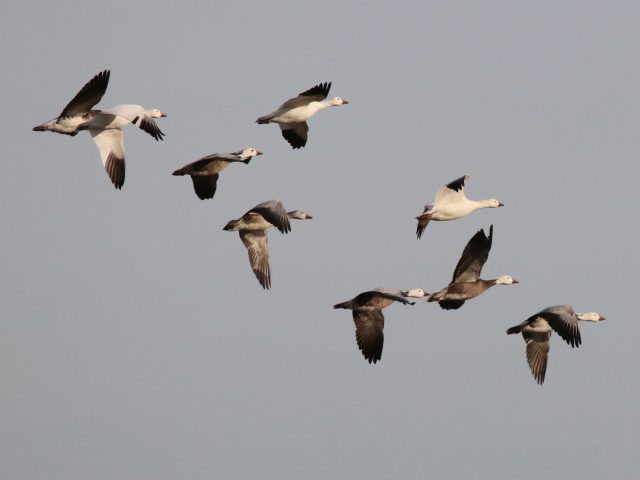



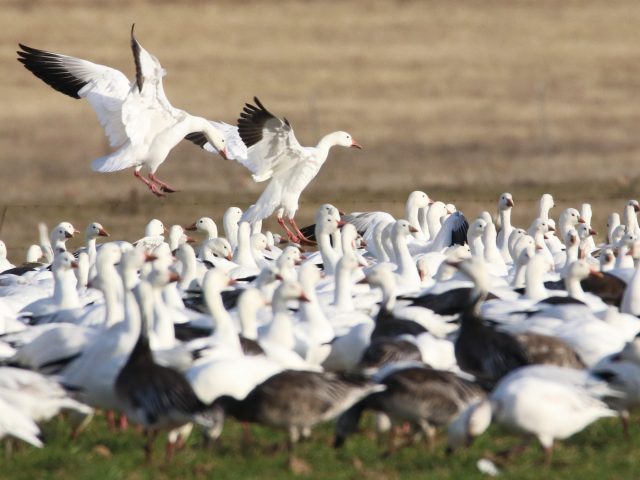




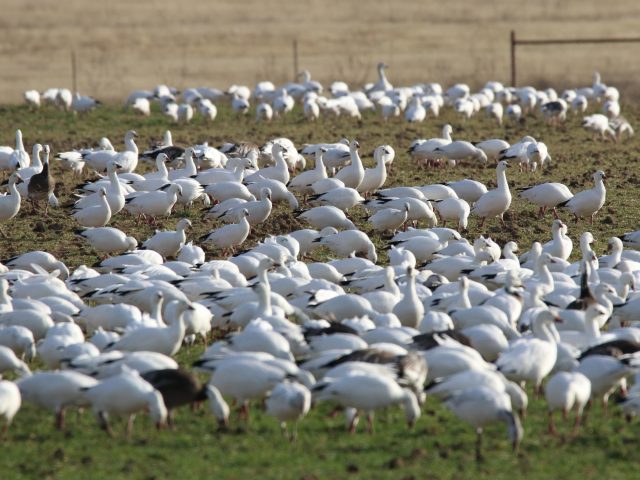


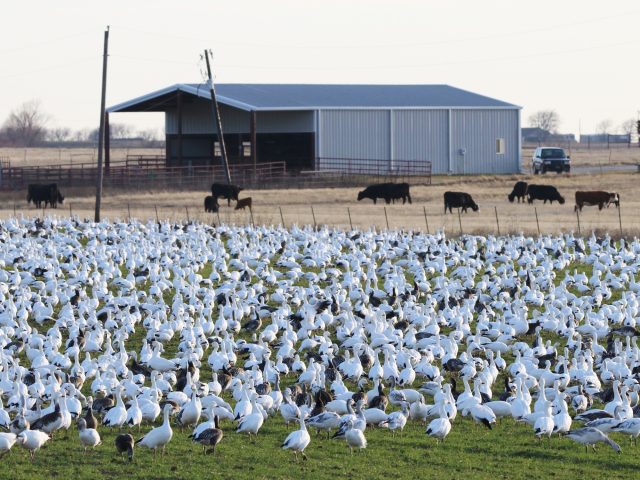







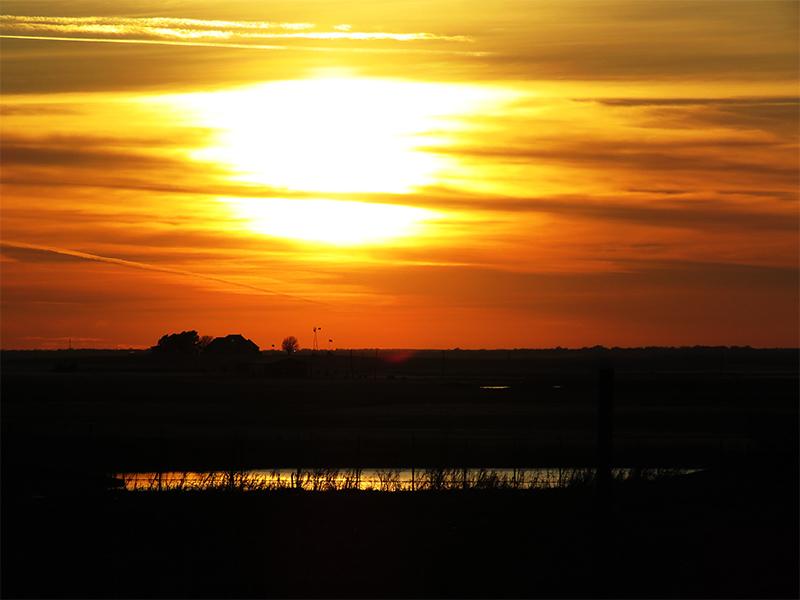





Another great story… I had the opportunity to see these great birds several years ago at Hagerman…
I saw the snow geese today! I was technically in Princeton, taking a photo of a thawing icy pond, when I heard honking overhead. Let me know if you want photos!
I got several videos of a huge flock in a field outside of Celina in late January of 2022, but wasn’t sure what kind they were. It looked a LOT like the images here!